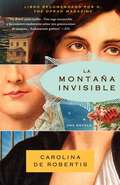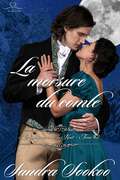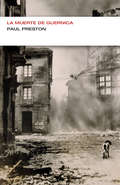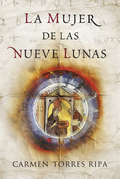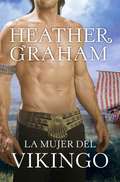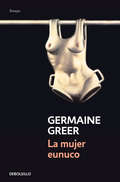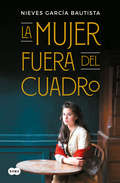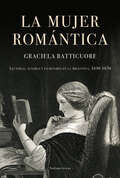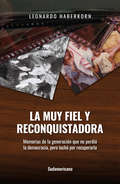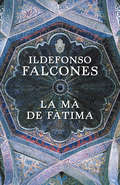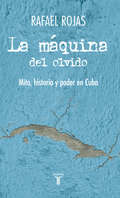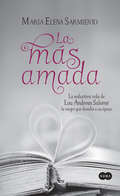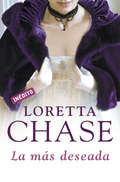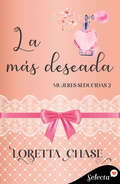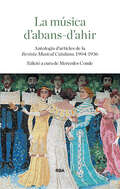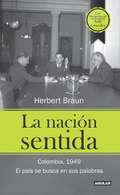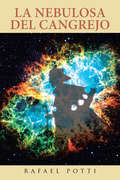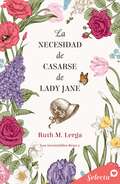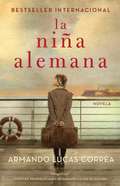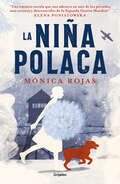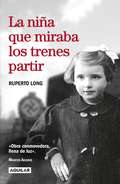- Table View
- List View
La montana invisible
by Carolina De Robertis"La clase de novela por la que uno se acuesta tarde para terminarla y acostado sigue pensando en ella". --The San Francisco Chronicle En el primer día del siglo XX, un pequeño pueblo en lo más profundo del campo uruguayo se reúne para ver un milagro --la misteriosa reaparición de Pajarita, una niña que se había perdido. Años después, Pajarita comenzará una estirpe ferozmente independiente, tres generaciones de mujeres que lucharán por crearse una vida en su querida Uruguay, una patria que nutre sus almas a la vez que pone a prueba sus espíritus: su hija Eva, una frágil pero ferozmente obcecada belleza decidida a ser poeta, se sobrepondrá a una desgarradora traición para seguir un camino poco convencional. Y la hija de Eva, Salomé, despertará tanto a la sensualidad como al compromiso político en medio de los turbulentos años sesenta. La montaña invisible es una mordaz celebración del poder del amor familiar, de la voluntad de supervivencia en las circunstancias más desesperadas y, sobre todo, del intenso vínculo entre madres e hijas.From the Trade Paperback edition.
La montana invisible
by Carolina De RobertisLa clase de novela por la que uno se acuesta tarde para terminarla y acostado sigue pensando en ella. The San Francisco Chronicle En el primer día del siglo XX, un pequeño pueblo en lo más profundo del campo uruguayo se reúne para ver un milagro la misteriosa reaparición de Pajarita, una niña que se había perdido. Años después, Pajarita comenzará una estirpe ferozmente independiente, tres generaciones de mujeres que lucharán por crearse una vida en su querida Uruguay, una patria que nutre sus almas a la vez que pone a prueba sus espíritus: su hija Eva, una frágil pero ferozmente obcecada belleza decidida a ser poeta, se sobrepondrá a una desgarradora traición para seguir un camino poco convencional. Y la hija de Eva, Salomé, despertará tanto a la sensualidad como al compromiso político en medio de los turbulentos años sesenta. La montaña invisible es una mordaz celebración del poder del amor familiar, de la voluntad de supervivencia en las circunstancias más desesperadas y, sobre todo, del intenso vínculo entre madres e hijas.
La morsure du comte: Les Seigneurs de la Nuit - Tome 2 (Les Seigneurs de la Nuit #2)
by Sandra SookooIl l’aime, mais ne parvient pas à la convaincre… Rafe Andrew Edward Astley, douzième comte de Devon, est victime d’une malédiction qui le transforme en vampire. Il est en paix avec cette part de lui-même depuis longtemps, mais s’il ne parvient pas à se libérer du vampire, il ne pourra jamais gagner l’amour de la seule femme qu’il ne peut oublier. La femme dont il est tombé amoureux il y a de nombreuses années et à qui il a pris ce qui ne lui appartenait pas. Pourtant, cette année, les fêtes de Noël pourraient être prometteuses. Elle désire l’homme, mais craint le vampire… Lady Elizabeth Sinclair, sœur cadette du duc de Manchester, est heureuse de la vie charitable qu’elle mène. Pourtant, elle se languit de vivre un amour exceptionnel. Plus mûre et plus sage que lors de sa dernière expérience en la matière, elle s’aventure sur le marché du mariage et se retrouve face à l’homme dont elle a peur, l’homme qui a bu son sang et pris son innocence onze ans auparavant, l’homme qu’elle désire toujours. Mais la terreur que son vampire lui inspire la rend méfiante, malgré la romance qui se profile entre eux. Une histoire d’amour légèrement tempêtueuse qui les emporte… Rafe et Elizabeth s’embarquent dans une relation amoureuse clandestine, malgré les obstacles dressés sur leur chemin. Emportés par leurs désirs, seule la compassion et une compréhension mutuelle leur permettront de trouver la clé pour les libérer de la peur à laquelle Elizabeth se raccroche et de la dépression contre laquelle Rafe se bat. Mais à l’heure de vaincre la malédiction, rien ne se passe comme prévu. Des dangers inattendus les guettent et ils ne sont pas causés par une créature de la nuit. Il leur faudra consentir à l’ultime sacrifice pour traverser les ténèbres et mériter une fin heureuse.
La muerte de Guernica
by Paul PrestonLa destrucción de Guernica el 26 de abril de 1937 quedó grabada a fuego en la conciencia europea: fue la primera ciudad «abierta» prácticamente arrasada por completo durante un bombardeo. Fueron tres horas de bombas y ametrallamientos en vuelos rasantes, un atroz ataque, perpetrado en día de mercado, que más tarde fue objeto de un terrible campaña de manipulación. En La muerte de Guernica, el prestigioso historiador Paul Preston, el hispanista más importante de la actualidad, nos cuenta la historia de ese bombardeo, desde las tácticas de la Legión Cóndor y sus tratos con Franco hasta la obsesión de Mola y la impagable labor de periodistas como George Steer. Así, en el 75º aniversario del bombardeo, entenderemos mejor el fuego de las llamas y distinguiremos el humo de las mentiras.
La muerte de Guernica (Colección Endebate #Volumen)
by Paul PrestonUn brillante ensayo sobre el bombardeo de Guernica que nos ayuda a entender mejor el fuego y las llamas y a distinguir el humo de las mentiras. La destrucción de Guernica el 26 de abril de 1937 quedó grabada a fuego en la conciencia europea: fue la primera ciudad «abierta» prácticamente arrasada por completo durante un bombardeo. Fueron tres horas de bombas y ametrallamientos en vuelos rasantes, un atroz ataque, perpetrado en día de mercado, que más tarde fue objeto de una terrible campaña de manipulación. En La muerte de Guernica, el prestigioso historiador Paul Preston, el hispanista más importante de la actualidad, nos cuenta la historia de ese bombardeo, desde las tácticas de la Legión Cóndor y sus tratos con Franco hasta la obsesión de Mola y la impagable labor de periodistas como George Steer.
La mujer de las nueve lunas
by CARMEN TORRES RIPAEn una época de oscurantismo y superstición, una mujer se atrevió a desafiar todos los tabúes de su tiempo. Monasterio de San Disibolo, Renania, 1118. Durante la noche, Hildegard descubre, enterrado en el jardín, el cuerpo de un recién nacido todavía con vida. Extrañada, se apresura a la celda de su novicia favorita y encuentra a la joven ensangrentada y moribunda... Ciudad del Vaticano, Roma, en la actualidad. Hasta ahora, el joven sacerdote Samuel Beyhe conocía la ruptura que supuso para la jerarquía eclesiástica la primera feminista de la historia: abadesa, profetisa, curandera, bruja, artista, escritora, compositora, visionaria, mística... Hildegard de Bingen fue uno de los personajes más fascinantes de la Edad Media. Pero Samuel no sabe por qué el Vaticano tiene un súbito interés en recuperar unos códices de Hildegard que llevan desaparecidos cientos de años, ni cuáles son los motivos para que se le haya encomendado la misión de encontrarlos. Lo que empieza siendo una investigación rutinaria, pronto se convierte en una vertiginosa carrera por descifrar una profecía que afectará irremediablemente al papel de la mujer en la iglesia. Y también en un peligroso juego donde la rompedora visión de Hildegard y los secretos que guardó en su seno todo este tiempo en torno a la verdad, la fe, el sexo y el amor, cambiarán la vida de Samuel para siempre.
La mujer del vikingo (Vikingos MacAuliffe #Volumen 2)
by Heather GrahamUn matrimonio forjado en el rencor y la desconfianza. Un amor por descubrir. El segundo volumen de la serie de los vikingos MacAuliffe. De la noche a la mañana Rhiannon, hija de un rey sajón, se ha visto convertida en una atractiva ofrenda. Su padre, deseoso de agradecer la ayuda que recibió de los vikingos de Irlanda en la lucha contra los agresores daneses, la ha entregado en matrimonio al aguerrido príncipe Eric. De nada sirve que ella se niegue con todas sus fuerzas. Sabe que está condenada a compartir su vida con un hombre tempestuoso y feroz por el que solo siente desconfianza y rencor. Pero en ocasiones los modales más rudos esconden virtudes insospechadas que solo los ojos más atentos pueden descubrir.
La mujer en la cueva
by Francisco LetamendiaPaís Vasco, septiembre de 1983, apenas un mes antes del comienzo oficial de las actividades de los GAL. Ane Goikoa, la mujer de Ramón Zubía, senador de la izquierda independentista, ha sido secuestrada por un grupo desconocido. Jean Houtsa, francés de origen vasco, emparentado con la mujer, es requerido para que haga labores de intermediación. Francisco Letamendia, Ortzi, ha hecho un paréntesis en el cultivo del ensayo, dentro del ámbito académico de la Ciencia Política que le es propio, para realizar esta incursión en la literatura de ficción. El tema elegido, así como el hecho de que el propio autor fuera en su día parlamentario independentista, podrían inducir al lector a pensar que se trata de una novela política, pero Letamendia prefiere considerarla como una novela negra, con todo lo que una novela que se precie de tal adjetivo puede ofrecer: secuestro, asesinatos, corrupciones policiales, intriga, con distintos misterios dentro de un enigma, y hasta un poco de erotismo. Contiene también, y esto es más inusual en las novelas negras, varias historias de amour fou, de amor más allá de la muerte. Puesto que es un relato imaginado, se podría decir, como en los títulos de crédito de las viejas películas, que todo parecido con la realidad es pura coincidencia, y, por tanto, el lector no tiene que preocuparse por ello? ¿O quizá sí?
La mujer eunuco
by Germaine GreerUn best seller internacional y un referente irremisible de la historia del feminismo. Cuando se publicó por primera vez en 1970, La mujer eunuco supuso un punto de inflexión en la defensa de los derechos de la mujer. La tesis sobre la que se sustenta el libro es que la familia nuclear, consumista y urbana reprime a la mujer sexualmente y esta acaba por desvitalizarse y convertirse en eunuco. Por esta razón, advierte Greer, la auténtica liberación pasa por una liberación sexual. Casi cinco décadas más tarde, este libro se ha convertido en un importante documento histórico y pone en relevancia todo el trabajo que queda por hacer. La crítica ha dicho...«Un libro con personalidad, un libro que conoce la distinción entre el yo y el otro, un libro que combina lo mejor de la masculinidad y la feminidad.»New York Times
La mujer fuera del cuadro
by Nieves García BautistaLa extraordinaria historia de una mujer, la del cuadro que la inmortalizó y la de una época, la bohemia parisina de finales del siglo XIX, tan bella como extrema en sus contrastes. ¿Cuántas historias caben en un cuadro? Barcelona, 1888. El joven León Carbó no responde a las expectativas de su padre de iniciarse en el negocio familiar. Prefiere la pintura, la noche, los burdeles y las tabernas. Su relación con un grupo anarquista lo pone en peligro y sus padres lo envían a París, donde por fin podrá dedicarse al arte y mezclarse con la efervescente intelectualidad de la ciudad. Sitges, 1905. Una niña a punto de cumplir diez años le pide a su madre un viaje a París como regalo. Para mostrarle los peligros de la ciudad, la madre le cuenta la historia de Madeleine Bouchard, una mujer que acabó asesinada en un cuartucho de Montmartre. Madrid, 2015. A Efrén, un periodista conocido por sus potentes exclusivas, le dan vacaciones forzosas en el periódico en el que trabaja y se va a París a reencontrarse con su novia de la adolescencia, su mejor amiga, a la que no ve desde hace años. Allí retoman la investigación acerca de la bohemia de finales del siglo XIX para terminar una novela que juntos comenzaron en la época del instituto. La mujer fuera del cuadro es el pequeño mundo donde se entretejen estas tres historias pobladas por personajes anónimos que tratan con personalidades como Degas, Mary Cassatt, Lautrec o Verlaine y en la que conviven con hitos históricos y referencias literarias y culturales de una época brillante por sus luces y sus sombras. *** A finales del siglo XIX, Montmartre era la alta colina donde los caminos del París clásico y luminoso se torcían. En este microcosmos asimétrico cohabitaban artistas y prostitutas, lavanderas y obreros, borrachos y pobres, ilusionados y desengañados. Y a este mundo de molinos, infraviviendas y salones de baile, a este ambiente tan turbio como excéntrico y singular, a esta pieza del París más bohemio y extremo, suben muchos: algunos para encontrar, otros para olvidar. A finales del siglo XIX las mujeres queríamos descubrir las pasiones que nos quitaran el sueño, a riesgo de perderlo para siempre. A punto de comenzar el siglo XX, levantábamos la voz para reclamar, para ser nosotras. Ahora, bien entrado el siglo XXI, y como aquellos herederos románticos, aún estamos recorriendo el mismo camino#
La mujer pintada
by Teresa Arijón¿Cómo sería la Historia del Arte si la contaran sus verdaderas protagonistas? Reinas, amantes, lolitas, prostitutas, actrices, trapecistas, bailarinas... hasta no hace mucho en la Historia del Arte las mujeres solo podían ser modelos. Profesionales como Kikí de Montparnasse en las fotografías de Man Ray o musas por azar como Victorine Meurant, la Olympia de Manet, que luego competiría con él. Íconos de las vanguardias como la alocada Henrietta Moraes, que inspiró a Bacon y Lucian Freud o la surrealista Claude Cahun, quien en 1930 proclamó: "Neutro es el único género que me viene bien". De la sonrisa de la Gioconda al color de la piel de Cleopatra, la cabellera de la Venus de Botticelli o el vello púbico de la vagina que pintó Courbet a pedido de un erotómano turco ?y que Lacan escondería en un doble muro de su estudio?, el misterio de sus identidades y aspectos obsesionó a ladrones, moralistas y académicos. Sus rostros y sus cuerpos pautan hasta hoy un ideal de belleza. Modelo durante décadas, Teresa Arijón da vuelta esa Historia del Arte en este libro excepcional e inclasificable. Erudito y caprichoso, es a la vez novela, ensayo, retrato y una crónica que va de la charla con una desenmascarada Guerrilla Girl en Nueva York, a las noches de bares porteños donde se encontraban las poetas, de la irrupción de Las Yeguas del Apocalipsis en Santiago a seguir por Río el rastro evanescente de Maria Bethânia. Entre la inmovilidad de la pose y los inevitables cambios físicos, La mujer pintada es también un registro sensible y sensual del paso del tiempo que permite que la autora invierta los roles y sea la modelo la que retrata a su artista. La crítica ha dicho... «Había que esperar a la pluma inigualable de Teresa Arijón para que la Historia del Arte encarnara, por fin, en sus verdaderas musas. Las modelos. Con sensibilidad inusual y coraje, Arijón ilumina el cuadro completo y trae no ya a las que posaron, sino a la legión venusina de las que fueron, las que son.»Julián López «Diga lo que diga, pensar en ella no me traiciona: la naturaleza de su mundo resulta de una mezcla de inteligencia y necesidad: un trabajo sensible, una sensibilidad tan seria como sus exhaustivas investigaciones, incluso las más serenas como este libro. ¿Qué le dice la belleza que todavía es su secreto?»Arturo Carrera «En La mujer pintada el mundo se vuelve materia desnuda. A la mujer mirada, mientras posa, se le revelan con toda naturalidad el refucilo de la belleza, la piel y el filo de los colores, el sol y las sombras de la historia de la pintura, el relámpago del deseo, la risa de la erudición. ¡Ay, la gracia! La alquimia verbal con la que Teresa Arijón se sienta frente al caballete y hace memoria. Y aquí nos deja con algo que deseábamos, pero desconocíamos, un fulgor, un libro en el cuerpo, una nueva felicidad.»Mercedes Araujo «París era una fiesta a la sombra de las guillotinas ornadas con flores de lis. Heme aquí, el rico argentino, azul zafiro de la cabeza a los pies. En traje de noche, imantado, con los guantes en la mano y una gardenia en el ojal. Proust à la Blanche, impávido, melancólico. Me arreglo el moño con desgano (debe quedar algo desprolijo, fortuito, vano). Enciendo la pipa de la dicha y contemplo a La mujer pintada.»Alfredo Prior
La mujer romántica: Lectoras, autoras y escritores en la Argentina, 1830-1870
by Graciela BatticuoreLa primera investigación sobre el arduo y reñido proceso en el que se transforma el lugar de la mujer, de lectora a escritora, en la Argentina del siglo XIX. Vida, obra, avatares y estrategias de las pioneras: Mariquita Sánchez, Juana Manuela Gorriti, Juana Manso y Eduarda Mansilla. La mujer romántica da cuenta de las diversas formas que asumieron los procesos a través de los cuales las primeras mujeres que serían reconocidas como escritoras en la Argentina alcanzaron el estatuto de autoras. Esos procesos y las circunstancias en que acontecieron estuvieron determinados histórica y socialmente por los conflictos políticos y los climas de ideas que atravesaron el siglo XIX argentino. En tiempos en que el género prefiguraba la habilitación a la lectura primero y, a partir de ella, a estadios como los de la escritura, la sociabilidad literaria y finalmente la publicación, algunas de las tácticas con las que las mujeres se abrieron camino fueron el anonimato, la seudonimia, la difusión restringida, los padrinazgos masculinos o las venias internacionales. La emergencia en el campo de la cultura de pioneras como Mariquita Sánchez, Juana Manuela Gorriti, Juana Manso y Eduarda Mansilla cuestionó lo dominante y dialogó necesariamente con las voces letradas reconocidas y legitimadas: Sarmiento, Alberdi, Gutiérrez, Quesada. Así, aparecieron en tensión axiomas o mandatos como los del amor, la maternidad y la familia por un lado y vocaciones, a veces embrionarias e intuitivas, otras conscientes y dispuestas a la disputa, relacionadas con ideas como las de emancipación, trabajo y producción intelectual, por el otro. Historiográficamente riguroso, teoréticamente reflexivo, analíticamente situado, críticamente agudo y en términos ensayísticos tan audaz como revelador y contemporáneo, este libro presenta la doble característica de clásico indispensable para la comprensión del pasado y herramienta potente para la intervención en los debates más urgentes del presente.
La muy fiel y reconquistadora: Memorias de la generación que no perdió la democracia, pero luchó por recuperarla
by Leonardo HaberkornCon un pulso periodístico y literario, Leonardo Haberkorn da voz a una generación que se plantó por la democracia. " Este libro no pretende ser la historia de la dictadura ni de la transición hacia la democracia. Es apenas un libro de memorias entrelazadas, testimonio de una generación que padeció la dictadura y siempre buscó los caminos para salir de ella ". Con estas palabras el periodista y autor de este libro, Leonardo Haberkorn, establece el pacto con el lector. En esta obra coral - donde la diversidad de las voces políticas es una regla - , las historias mínimas y las más grandilocuentes van tejiendo el relato de una generación que resistió y venció al autoritarismo con la razón, la valentía y el corazón. A lo largo de estas páginas el lector podrá cruzarse con historias sobre la libertad de prensa, sindical, estudiantil. Desde el #plebiscito del No# en 1980 a las elecciones de 1985; de la organización de un paro estudiantil al #río de libertad# y el 1.° de Mayo de 1983; la resistencia clandestina de los partidos políticos y organizaciones sociales, la llegada de Wilson, la libertad de Seregni y la asunción de Sanguinetti a la presidencia.
La mà de Fàtima
by Ildefonso FalconesA l'opulenta Còrdova de la segona meitat del segle XVI, un jove morisc, esquinçat entre dues cultures i dos amors, emprèn una lluita ardent per la tolerància religiosa i els drets del seu poble. La història d'un jove atrapat entre dues religions i dos amors, a la recerca de la seva llibertat i la del seu poble, a l'Andalusia del segle XVI. El 1568, a les valls i les muntanyes de Las Alpujarras, esclata el crit de la rebel·lió: tips d'injustícies, espoliacions i humiliació, els moriscos s'enfronten als cristians i inicien un combat desigual que només podia acabar amb la derrota i la dispersió dels primers per tot el regne de Castella. Entre els sollevats hi ha el jove Hernando. Fill d'una morisca i d'un capellà que la va violar, és rebutjat pels seus a causa del seu origen, i pels cristians, a causa de la cultura i els costums de la seva família. Durant la insurrecció coneixla brutalitat i la crueltat dels uns i els altres, però també troba l'amor en la figura de la valerosa Fàtima, de grans ulls negres. Després de la derrota, forçat a viure a Còrdova i enmig de les dificultats de la vida quotidiana, dedicarà totes les seves forces a fer que la seva cultura i la seva religió, la dels vençuts, recuperin la dignitat i el paper que els correspon. Per això haurà de córrer riscos i atrevir-se a dur a terme iniciatives audaces i perilloses... Els lectors de L'església del mar trobaran en aquesta segona novel·la d'Ildefonso Falcones les mateixes claus que varen proporcionar l'èxit a la primera: la fidelitat històrica s'encreua amb un apassionant relat d'amor i odi, d'il·lusions perdudes i esperances que donen sentit a la vida i la condueixen pels camins de l'aventura. D'aquesta manera, l'autor construeix una novel·la trepidant que pretén reflectir la tragèdia del poble morisc, ara que es compleix el quart centenari de la seva expulsió d'Espanya, alhora que explica una vida singular, la d'un home entre dues cultures i enamorat, que mai no es resigna a la derrota i lluita per la convivència. Ressenya:«Manté l'expectació del lector al llarg del voluminós metratge, defuig de la predicibilitat, s'apropa a l'ideari dels autors francesos i italians (passió, revenja, esperança i justícia) i captura l'interès amb múltiples subtrames que actuen com a llibres en cadena.»El Periódico de Catalunya
La máquina del olvido
by Rafael RojasEn la actualidad, los defensores y opositores del régimen surgido de la Revolución Cubana se encuentran sumidos en una discusión que trasciende los límites de la isla y que obliga a cuestionar la historia oficial y las consecuencias que ésta ha tenido para el desarrollo de esa nación. La máquina del olvido explora esas tensiones de la Cuba contemporánea a través de ocho ensayos. Cada uno de ellos enfocado en analizar la experiencia de memoria y olvido desde un ángulo diferente: ideológico, literario, constitucional, intelectual, socialista, del conflicto entre Estados Unidos y Cuba, de la cultura popular, y de las diversas opciones de futuro que se debaten en la isla y en el exilio. Es ese enfrentamiento entre el modelo de Fidel Castro y las posturas críticas de los jóvenes historiadores lo que está construyendo la nueva consciencia cubana y reescribiendo su historia. Esa consciencia crítica frente al discurso único es lo que despertará (y está despertando) a una sociedad acostumbrada a pasar sus ideas por el tamiz del pensamiento oficial y hará que se rebele contra la máquina del olvido que ha legitimado a ese régimen desde hace más de medio siglo.
La más amada: La seductora vida de Lou Andreas Salomé, la mujer que desafió a su época
by María Elena SarmientoLa impactante vida de una mujer que cautivó a su épocaBiografía novelada sobre Lou Andrea Salomé, quien abrió brecha en una época en que las mujeres no podían acceder al conocimiento, luchó contra los prejuicios, incluso de sus seres más cercanos, apostó por tener una vida independiente y cautivó a las mentes más brillantes de su tiempo, como Freud, Nietzsche y Rilke. Una novela basada en una amplia documentación, que nos revela todas las facetas de este personaje fascinante: la escritora capaz de renunciar a todo por el conocimiento, la joven que escandaliza a su propia familia y a los círculos intelectuales europeos, la mujer que seduce a aquellos que la conocen...
La más deseada (Mujeres seducidas #Volumen 2)
by Loretta ChaseUna ardiente pareja con habilidades insospechadas. Las pasiones que levantan pueden llevarlos a la cumbre... o arrastrarlos a la ruina. En 1818, la joven Zoe Lexham regresa a Inglaterra tras años encerrada en el harén de un pachá, donde se ha convertido en una maestra de las artes amatorias. Conoce todo lo que una joven dama no debería siquiera oír. Es, en definitiva, un escándalo andante sin ningún futuro decoroso... a no ser que alguien logre civilizarla. Lucien de Grey, el duque de Marchmont, no es ningún caballero de armadura resplandeciente. Al contrario, es un peligro para las mujeres: las hechiza, las seduce y las abandona, dejando tras de sí un rastro de regalos que sirve de paño de lágrimas a las pobres muchachas. Cuando a Zoe y el duque les interese ser aceptados de nuevo en la alta sociedad londinense, solamente se tendrán el uno al otro...
La más deseada (Mujeres seducidas #Volumen 2)
by Loretta ChaseUna ardiente pareja con habilidades insospechadas. Las pasiones que levantan pueden llevarlos a la cumbre... o arrastrarlos a la ruina. En 1818, la joven Zoe Lexham regresa a Inglaterra tras años encerrada en el harén de un pachá, donde se ha convertido en una maestra de las artes amatorias. Conoce todo lo que una joven dama no debería siquiera oír. Es, en definitiva, un escándalo andante sin ningún futuro decoroso... a no ser que alguien logre civilizarla. Lucien de Grey, el duque de Marchmont, no es ningún caballero de armadura resplandeciente. Al contrario, es un peligro para las mujeres: las hechiza, las seduce y las abandona, dejando tras de sí un rastro de regalos que sirve de paño de lágrimas a las pobres muchachas. Cuando a Zoe y el duque les interese ser aceptados de nuevo en la alta sociedad londinense, solamente se tendrán el uno al otro...
La música d'abans-d'ahir: Antologia d'articles de la Revista Musical Catalana. 1904-1936
by Mercedes CondeEl present llibre és una selecció d’articles publicats a la Revista Musical Catalana, butlletí oficial de l’Orfeó Català, entre els anys 1904 i 1936. Testimoni directe d’una època daurada de la cultura catalana, la Revista Musical Catalana és el mirall de l’activitat musical que es desenvolupa als països catalans, però també de l’activitat internacional dels seus músics i compositors, així com de la realitat musical internacional. Amb un clar interès per l’activitat coral, retrata les estrenes musicals més importants en l’època, la construcció del Palau de la Música Catalana, l’inici de la recuperació de la música antiga i de la interpretació amb criteris històrics, els concerts més representatius del moment i l’activitat dels instrumentistes catalans arreu del món.
La nación sentida: Colombia, 1949. El país se busca en sus palabras
by Hebert Tico BraunUn libro que estudia lo qué pasó después de 'El Bogotazo. Como continuación de Mataron a Gaitán, Herbert Braun propone una mirada a los meses que siguieron al 9 de abril. <p><p>Por medio de telegramas, cuentos, artículos de prensa y discursos, recupera las impresiones de personajes públicos y anónimos durante el crítico año de 1949, cuando los colombianos de arriba abajo sentían el temblor de su época y presentían su futuro. <p> La nación sentida es un libro de historia fuera de lo común y, como tal, tiene el don de revivir las pasiones olvidadas por la historia oficial. <p> Al conectar distintos relatos, Braun compone un texto fascinante en el que consigue captar la sensibilidad de un país: los comportamientos, lostratos sociales y la cotidianidad donde se cifran las condiciones históricas y las circunstancias que dieron forma a la Colombia actual.
La nebulosa del cangrejo
by Rafael PottiLos acontecimientos se desvanecen al nacer, la búsqueda constituye el presente. <P><P>Todos los demás son maestros, de unos cogerás buen consejo, de otros imitarás su ejemplo, de otros rechazarás lo que hagan o digan, pero de todos aprenderás y aún más de los que son diferentes. <P><P>La búsqueda de su camino lleva al joven Lí a dejar a su maestro en la tranquilidad de su natal Catay en la primavera del año 1050 y partir en un viaje hacia un lejano y para él muy incierto Occidente. <P><P>Su recorrido físico y también espiritual lo llevará a conocer a su amigo Gazir en Ceilán y en un contexto de incertidumbre sobre el cambio de milenio y las creencias sobre la posible llegada del fin del mundo, presenciar juntos hechos trascendentes como las batallas entre cristianos y musulmanes por diferencias de fe que ellos no pueden comprender, o la búsqueda de independencia de la iglesia delpoder político y su división luego del Cisma de Oriente y Occidente. <P><P>La nebulosa del cangrejo nos invita a recorrer un periodo intenso del Medioevo en un viaje donde la fe, la esperanza y la búsqueda de conocimiento interior se enriquecen en el encuentro con el otro.
La necesidad de casarse de lady Jane (Los irresistibles Beau #Volumen 2)
by Ruth M. LergaCuando has de casarte con urgencia sin importar con quién, enamorarse solo sirve para que, de repente, cualquier candidato parezca una decisión abominable. Así que, ¿por qué Cupido se empeña en hacer que Jane y Malcolm se encuentren a cada momento, si están destinados a no elegirse? Lady Jane Montague ha sido prometida por el cabeza de familia de los Beaufort a un hombre cuarenta y siete años mayor que ella. Pero su familia ha urdido un plan para desafiar al duque de Rule y dar a la joven una oportunidad de ser feliz: simularán una enfermedad contagiosa que la obligue a estar incomunicada durante seis semanas y, durante ese plazo, huirá a Edimburgo en busca de un esposo más adecuado. Laird Malcolm Kincaid, conde de Divach, tiene que casarse con una heredera para salvar su herencia de una hipoteca inesperada. Encuentra pronto a la prometida perfecta y huye con ella, para que esta le deje plantado el mismo día de la boda. Y, para mayor castigo, el destino pone en su camino un instante después a lady Jane, una diosa inglesa capaz de hacerle olvidar sus obligaciones condales. Jane desea al apuesto escocés, pero a pesar de sus prisas por contraer matrimonio, cree merecer un esposo que, al menos, no acabe de ser plantado por otra mujer a las puertas de la iglesia. Y, aun así, ninguno le interesa tanto como el apuesto highlander, con quien coincide en cada baile al que acude. ¿Puede un mal principio tener un buen final tras la pasión de un primer beso?
La niña alemana (The German Girl Spanish edition): Novela
by Armando Lucas CorreaUna novela inolvidable ambientada en el Berlín de la primavera de 1939, la Cuba pre- y postrevolucionaria y el Nueva York después del 11 de septiembre.Antes de que todo se desmoronara, Hannah Rosenthal y sus padres tenían una vida encantadora. Su familia, una de las más distinguidas en los altos círculos sociales berlineses, era admirada por amigos y vecinos. Ahora en 1939, Berlín se ha teñido de los colores blanco, rojo y negro de una bandera que no reconocen como suya. Hannah se refugia con su mejor amigo, Leo Martin, en los callejones y parques de una ciudad que ya no los quiere. Los dos niños hacen un pacto: pase lo que pase, se prometen un futuro juntos. Un rayo de esperanza les llega a los Rosenthal y los Martin: el Saint Louis, un enorme y lujoso trasatlántico partirá de Hamburgo a Cuba con más de novecientos refugiados judíos. En la medida que todos los pasajeros se van llenando de ilusión por el brillante futuro que les espera, el amor de Hannah y Leo florece entre juegos, bailes de disfraces y cenas exquisitas. Hasta que empiezan a llegar noticias funestas desde La Habana cuyo gobierno prohíbe al barco atracar en el puerto. El majestuoso navío, que parecía la única salvación para ellos, podría terminar convirtiéndose en su pena de muerte. Siete décadas más tarde, en Nueva York, a punto de cumplir sus doce años, Anna Rosen recibe, procedente de Cuba, un misterioso sobre de Hannah, su tía abuela, a quien nunca conoció. En un intento por armar el rompecabezas del pasado de su familia, Anna y su madre deciden viajar a encontrarse con Hannah. Al entrelazar el dolor del pasado con los misterios del presente, revive la memoria de un apellido olvidado y, a su vez, les rinde honor a aquellos que amó y que trágicamente perdió.
La niña polaca
by Mónica RojasLa novela de Mónica Rojas no solo destierra del olvido la tragedia de la ocupación de Polonia durante la Segunda Guerra Mundial, sino que reivindica la importancia de la que será conocida desde entonces como La Pequeña Polonia en México. Agosto de 1939. Mientras los líderes de la Unión Soviética y la Alemania nazi se reúnen en Moscú para repartirse los territorios de Polonia, la joven Ania juega en el campo, ajena a toda barbarie. Sin embargo, todo cambia tras la ocupación de su pueblito Komarno por tropas bolcheviques: ella y su familia serán trasladados al Gulag siberiano, donde trabajarán sin descanso bajo un frío inclemente, arriesgando cada día su integridad física y viviendo bajo el despiadado peso de la desesperanza. Para sobrevivir, Ania deberá atenerse a los recuerdos de Cezlaw, su primer amor; a la bondad de la anciana Olga, quien mantiene viva su curiosidad gracias a sus historias; y a la tierna devoción de sus padres. Por fortuna el destino quiso para Ania la oportunidad de abandonar el trabajo forzado y emigrar. Junto con su familia y otros muchos polacos, y tras una travesía extenuante, se instalarán en la Hacienda de Santa Rosa en Guanajuato, México, donde por fin encontrarán la redención y una nueva patria. En palabras de la crítica
La niña que miraba los trenes partir
by Ruperto LongLa estremecedora novela de Ruperto Long surge de una investigación profunda sobre una época en la que confluyeron xenofobias, persecuciones, guerras y migraciones. Años cuarenta del siglo xx, en un mundo azotado por los conflictos bélicos. Charlotte, una niña belga de ocho años, desaparece de la Lieja ocupada por los nazis, dejando atrás su casa y su infancia feliz. Junto con la familia huye de los perseguidores, viviendo increíbles peripecias y ocultándose en míseros escondites de pueblos y ciudades. Alter, su tío, obligado a desempeñar funciones en uno de los guetos donde Hitler ordena confinar a los judíos #incluidos los padres del muchacho#, debe afrontar una extrema disyuntiva ética. Dimitri Amilakvari, militar francés de origen georgiano, desembarca en el norte de África al frente de la mítica Legión Extranjera, para enfrentar al mariscal alemán Rommel y su temido Afrika Korps. Domingo López Delgado, un soldado uruguayo, se enrola como voluntario en las fuerzas de la Francia Libre y es destinado a la Legión Extranjera en Bir Hakeim, África del Norte, donde será testigo de la grandeza humana de su superior, Amilakvari, y ambos participarán en un combate legendario. Cuatro historias de vida que se entrelazan para transportarnos en el tiempo. La estremecedora novela de Ruperto Long surge de una investigación profunda sobre una época en la que confluyeron xenofobias, persecuciones, guerras y migraciones. Sin embargo, más allá de esos hechos siniestros que la humanidad arrastra hasta nuestros días, el narrador rescata de la realidad historias de amor #entre padres e hijos, entre hermanos, entre amantes, entre amigos#, impregnadas de una empecinada defensa de la vida, de la libertad, del prójimo, de la tierra natal: múltiples relatos de afectos que triunfan y perduran más allá de la barbarie.
